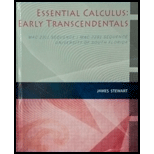
Concept explainers
(a)
To write: An expression for a double Riemann sum of the given function.
(a)
Answer to Problem 1RCC
The expression for a double Riemann sum is
Explanation of Solution
Given that the continuous function
The double integral of f over the rectangle R is given by,
Here,
The given continuous function is
The sample points of each rectangle is denoted by
The image value of the sample points under the function
The sum mentioned above
(b)
To write: The definition of
(b)
Answer to Problem 1RCC
The definition of
Explanation of Solution
The double integral can be expressed in terms of double Riemann sum as follows:
The double integral of f over the rectangle R is,
Here,
The given continuous function is
The sample points of each rectangle is denoted by
The image value of the sample points under the function
Thus, the definition of
(c)
To write: The geometric interpretation of
(c)
Explanation of Solution
When
If suppose the given function f takes both positive and negative values, then it does not denote the volume exactly. But, it is taken that the volume of the function of the two graphs one above the xy-plane and one below the xy-plane.
(d)
To evaluate: The value of the double integral
(d)
Answer to Problem 1RCC
The value of
Explanation of Solution
Rewrite the indefinite double integral by definite double integral from the equations or inequalities in the given rectangle. Then, as per the rules of
Thus, the value of
(e)
To interpret: About the Midpoint Rule for double integrals.
(e)
Explanation of Solution
The double integral,
Here,
The given function is
The mid points of each rectangle is denoted by
The Riemann sum constants are denoted by m, n.
Separate the given region by small rectangles by the method of Riemann sum for the double integrals. Then, pick the sample points from the Midpoint of each rectangle.
Want to see more full solutions like this?
Chapter 12 Solutions
Essential Calculus: Early Transcendentals; MAC 2311 Sequence| MAC 2281Sequence USF (Essential Calculus)
- i don't understand how to get these answers please help!arrow_forwardEnter your answer in interval notation. No decimal entries allowed. Type oo (lower case o) for ∞ and -oo for -∞ if needed. Domain: Question Help: Message instructorarrow_forwardWrite a formula for the function g that results when the graph of the function f(x) = = 4 X is reflected about the y-axis, horizontally compressed by a factor of 2, shifted 7 units left, reflected about the x-axis and shifted 3 units up. g(x): = Question Help: Message instructorarrow_forward
- Question 7 4 pts 1 Details The value of China's exports of automobiles and parts (in billions of dollars) is approximately f(x) = 1.8208e0.3387x, where x = 0 corresponds to 1998. In what year did/will the exports reach $10.4 billion?arrow_forwardQuestion 7 4 pts 1 Detai The value of China's exports of automobiles and parts (in billions of dollars) is approximately f(x) = 1.8208e 0.3387x, where x = 0 corresponds to 1998. In what year did/will the exports reach $10.4 billion?arrow_forwardWrite a formula for the function g that results when the graph of the function f(x) = = 4 X is reflected about the y-axis, horizontally compressed by a factor of 2, shifted 7 units left, reflected about the x-axis and shifted 3 units up. g(x) = Question Help: Message instructorarrow_forward
- Question 3 Use the graph of f to evaluate the following: 3 pts 1 D 6 f(x) 5 4 3 2 1 -1 1 2 3 4 5 เค -1 x The average rate of change of f from 1 to 4 =arrow_forwardB Find the domain the function graphed below. Express in interval notation 5 3 pts 1 De 3 2 1 -5 -4 -3 2 -1 2 3 4 5 -2 -3 -4 5 Domain:arrow_forwardFind the domain the function graphed below. Express in interval notation 3 2 -5 4-3 12 -1 1 2 3 4 2 -3- 4 5+ Domain: Question Help: Message instructor Question 3arrow_forward
 Algebra & Trigonometry with Analytic GeometryAlgebraISBN:9781133382119Author:SwokowskiPublisher:Cengage
Algebra & Trigonometry with Analytic GeometryAlgebraISBN:9781133382119Author:SwokowskiPublisher:Cengage College Algebra (MindTap Course List)AlgebraISBN:9781305652231Author:R. David Gustafson, Jeff HughesPublisher:Cengage Learning
College Algebra (MindTap Course List)AlgebraISBN:9781305652231Author:R. David Gustafson, Jeff HughesPublisher:Cengage Learning College AlgebraAlgebraISBN:9781305115545Author:James Stewart, Lothar Redlin, Saleem WatsonPublisher:Cengage Learning
College AlgebraAlgebraISBN:9781305115545Author:James Stewart, Lothar Redlin, Saleem WatsonPublisher:Cengage Learning



